
|

|
|
Home Site Search Contact Us Subscribe
|
|
|
INSIGHT: When to Remember Not to Renovate The story of the Berkeley South Branch Library is a case study of when a Midcentury Modern building is arguably best remembered and respected through photographic and historic archives rather than reuse. By Avery Taylor Moore, AIA, Field Paoli Architects September 5, 2014 Midcentury Modernism left a legacy of well-designed buildings. We save the significant landmarks like Louis Kahn’s Salk Institute or Kevin Roche’s Ford Foundation – renovating and adding on to them so they continue to work for contemporary use. However, across the land are small functional buildings from the 1930s through the mid-1960s that are not landmarks, yet deserve some recognition. Many factors – age, poor construction, disrepair, inexpensive or experimental materials, changing use patterns, and lack of accessibility – make it impossible to renovate all of these into vibrant and useful buildings. Rather than let Midcentury Moderns fall prey to façadism, where the façades are preserved but the rest of the building is demolished and replaced, it may be best to remember and respect some of these in their original state through photographic and historic archives rather than reuse. The story of a recently replaced northern California library illustrates this point.
In the late 1950s, Berkeley’s original South Branch Library was found to be structurally unsound and had to be closed. The office of local architect John Hans Ostwald was brought in quickly to design a replacement at another site in a residential neighborhood. Time and budget were of the essence; the new library, at the corner of Martin Luther King Boulevard and Russell Street, was completed in 1961 for $64,000.
The 1960s facility was thoughtful and well proportioned for its time and place, and it was clearly influenced by the designs of Frank Lloyd Wright. The main space comprised two small, inward-focused reading rooms. A small staff area and two tiny toilet rooms completed the program. There was a small courtyard off the children's room, rarely used due to traffic noise. Later, with the acquisition of more land, a wraparound driveway with convenient parking was created at the rear of the site. A community room was added in 1974, also designed by Ostwald's office but with less rigor, and in 1991, a small attached building was added to replace an on-site trailer housing the popular city-wide tool lending library.
The iconic black-and-white photographs taken by Karl H. Reik do the best job of telling the story of what made the 1961 South Branch memorable. They show the clean proportions, the pyramidal hemlock ceiling in the main adult reading room that contrasted with the flat ceiling in the adjoining children's room, concrete floors with radiant flooring, and unpainted concrete block walls. There were only hints of ornament in the glass inserts in the top coursing of block and in the simple patterning on the floor.
By 2008, the library required seismic upgrades. Spaces were inaccessible to the disabled, and the communities and library programs had outgrown the site.
There were strong reasons to consider replacing the old facility with a new one, and most of the community supported the idea. A few members of the public protested, which can happen when long-valued buildings have outgrown their use. It can be hard to let go of shared public spaces that are full of happy memories. There is a conviction that architectural restoration and well-designed additions are always achievable and preferable to building new. And there is a belief that historic structures, particularly the “modest moderns” of the 1950s and 60s, are not well respected and require determined advocacy, including litigation if need be. Interestingly, a similar outcry rose up around the same time over the decision to replace the midcentury North Beach Library in San Francisco – for similar reasons – even though its original appearance and layout had been altered significantly by previous renovations.
The decision to replace or not has to be made carefully, with consideration of the alternatives. At South Branch, a subcommittee of the Berkeley Landmarks Commission (including two outside architects) met three times with the Field Paoli architectural team to explore possible additions to the existing building that would be organized around the original adult reading room. In the end, the schemes fell short of needed space and access, or relegated some program areas to a new second floor that overshadowed the smaller pyramidal roof. It was not a compromise that the architects, library staff, or community supported.
Respecting the legacy of precedent buildings is important. But program and building code requirements have changed over more than 40 years, and that often does require new infrastructure and expanded and updated program areas.
The new South Branch opened in May 2013. It is 8,700 square feet, approximately 60% larger than its predecessor to accommodate current program needs and patterns of use. It offers accessibility for the disabled throughout, a separate teen area, nooks for talking as well as studying in many spaces, larger media collections, more technology, and a larger community room for day and evening meetings. Sustainable features are apparent in materials, new utilities, expansive daylight, and cooling from operable clerestory windows in the central browsing area, where the ceiling is more than 20 feet high. The library recently received LEED Gold certification.
The drawings and photographs of the Hans Ostwald library have now been gathered at Berkeley's Central Library. Keeping the legacy of Modernism alive is important, but there are many ways to achieve this. Sometimes that can mean restoration or adaptive reuse. But sometimes the best solution for public use, especially in situations of potential hazard or lack of access, is to preserve documentation of these buildings at their best, and to create new structures to meet the broad range of contemporary community needs.
Avery Taylor Moore, AIA, is a principal at Field Paoli Architects in San Francisco. |
(click on pictures to enlarge) 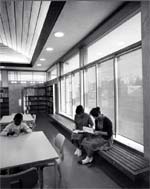 Karl H. Riek, courtesy of the Berkeley Public Library Berkeley South Branch Library: 1961 photo of the original library interior. 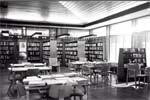 Karl H. Riek, courtesy of the Berkeley Public Library Berkeley South Branch Library: 1961 photo of the original library interior.  David Wakely Photography The new Berkeley South Branch Library replaced a smaller existing library on a small corner lot. Solid stained cedar siding and steel canopies provide a contemporary setting. With solar panels and radiant flooring, the new library has been submitted for LEED Gold certification. 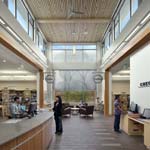 David Wakely Photography The two-story central browsing area fills the small library with daylight and natural ventilation through high, operable clerestory windows. Reclaimed cypress wood arches frame entrances to reading rooms and staff area. Custom-printed glass in the lounge area is by Skyline Design. 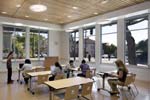 David Wakely Photography The new community room embraces the active neighborhood outside and is designed to allow after-hours use. 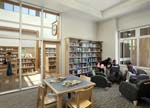 David Wakely Photography Teens now have their own enclosed study and lounge area. 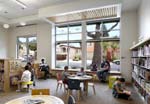 David Wakely Photography A window seat in the children’s room offers one of many places to read.  Cory Clinton, RSM Design New library signage draws on tool colorways and bold graphics to create a unique neighborhood place. Three exterior stained glass and copper mosaics are by artist Gina Dominguez. 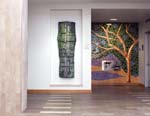 David Wakely Photography A fired clay sculpture by Stephen De Staebler was a gift to the original library and is displayed prominently, placed near Canopy of Circles, a new stained glass and copper mosaic by artist Gina Dominguez selected for the library’s 2013 public art commission. 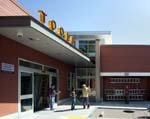 David Wakely Photography The Berkeley South Branch Library includes a special Tool Lending Library with tools loaned free to anyone with a Berkeley driver’s license. 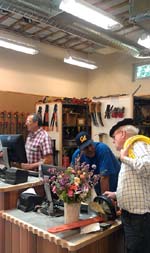 Field Paoli Architects The tool library space is raw, with exposed utilities suitable to its purpose. |
© 2014 ArchNewsNow.com